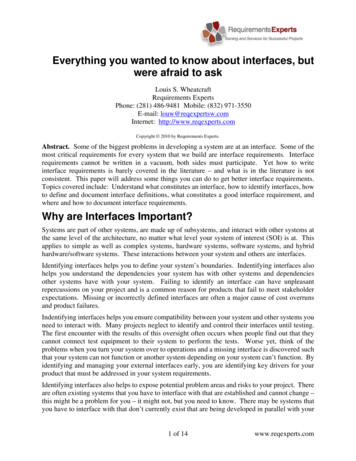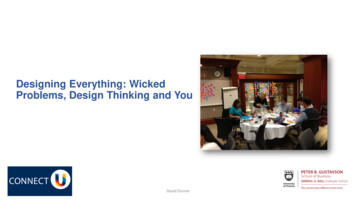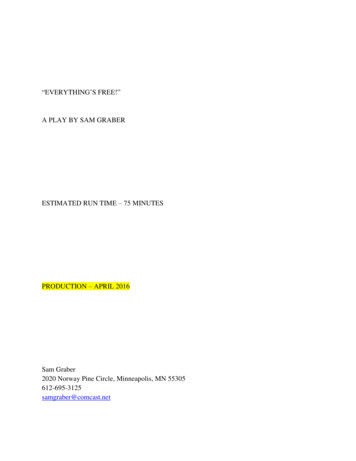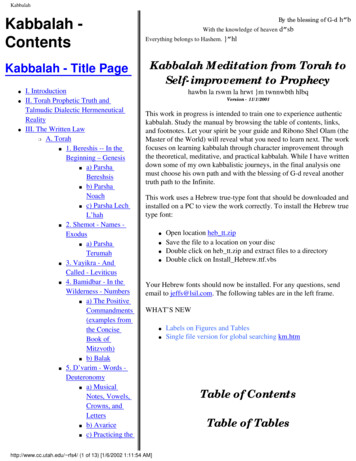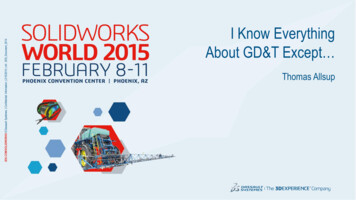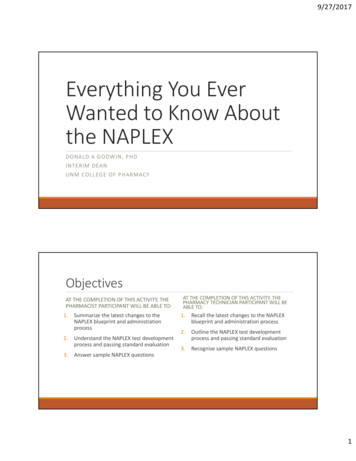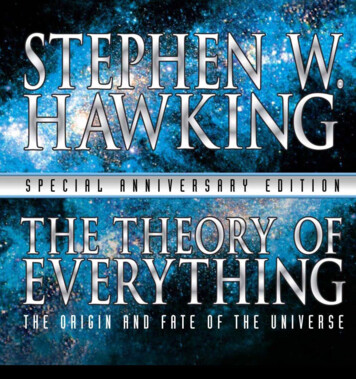
Transcription
STEPHEN W.HAWKINGS P E C I A LA N N I V E R S A R YE D I T I O NTHE THEORY E ORIGIN AND FATE OF THE UNIVERSEPHOENIXBOOKS
Copyright 2005 Phoenix BooksFirst published under the title The Cambridge Lectures:Life Wo r k s Copyright 1996 by Dove Audio, Inc.All rights reserved. Written permission must be secured from the publisherto use or reproduce any part of this book, except brief quotations in criticalreviews and articles.ISBN: 1-59777-508-8Library of Congress Cataloging-In-Publication Data AvailableBook Design by Sonia FiorePrinted in the United States of America5F9A4512-DBD2-4640-B53D-F3CF22FFE0A2Phoenix Books9465 Wilshire Boulevard, Suite 315Beverly Hills, CA 9021210 9 8 7 6 5 4
CONTENTSIntroductionFIRST LECTUREideas about the universe . . . . . . . . . . . . . . . . . . . . . . .1SECOND LECTUREthe expanding universe . . . . . . . . . . . . . . . . . . . . . . . .13THIRD LECTUREblack holes . . . . . . . . . . . . . . . . . . . . . . . . . . . . . . . . .35FOURTH LECTUREblack holes ain’t so black . . . . . . . . . . . . . . . . . . . . .57FIFTH LECTUREthe origin and fate of the universe . . . . . . . . . . . . .77SIXTH LECTUREthe direction of time . . . . . . . . . . . . . . . . . . . . . . . . .103SEVENTH LECTURE5F9A4512-DBD2-4640-B53D-F3CF22FFE0A2the theory of everything . . . . . . . . . . . . . . . . . . . . .119INDEX . . . . . . . . . . . . . . . . . . . . . . . . . . . . . . . . . . . . . . . . . .137
5F9A4512-DBD2-4640-B53D-F3CF22FFE0A2INTRODUCTION
INTRODUCTIONIn this series of lectures I shall try to give an outline of what we think is thehistory of the universe from the big bang to black holes. In the first lectureI shall briefly review past ideas about the universe and how we got to ourpresent picture. One might call this the history of the history of the universe.In the second lecture I shall describe how both Newton’s and Einstein’s theories of gravity led to the conclusion that the universe could not be static; ithad to be either expanding or contracting. This, in turn, implied that theremust have been a time between ten and twenty billion years ago when thedensity of the universe was infinite. This is called the big bang. It would havebeen the beginning of the universe.5F9A4512-DBD2-4640-B53D-F3CF22FFE0A2In the third lecture I shall talk about black holes. These are formed when amassive star or an even larger body collapses in on itself under its owngravitational pull. According to Einstein’s general theory of relativity, anyonefoolish enough to fall into a black hole will be lost forever. They will not beable to come out of the black hole again. Instead, history, as far as they areconcerned, will come to a sticky end at a singularity. However, generalrelativity is a classical theory—that is, it doesn't take into account theuncertainty principle of quantum mechanics.IV
INTRODUCTIONIn the fourth lecture I shall describe how quantum mechanics allows energy toleak out of black holes. Black holes aren’t as black as they are painted.In the fifth lecture I shall apply quantum mechanical ideas to the big bang andthe origin of the universe. This leads to the idea that space–time may be finitein extent but without boundary or edge. It would be like the surface of theEarth but with two more dimensions.In the sixth lecture I shall show how this new boundary proposal could explainwhy the past is so different from the future, even though the laws of physics aretime lly, in the seventh lecture I shall describe how we are trying to find aunified theory that will include quantum mechanics, gravity, and all the otherinteractions of physics. If we achieve this, we shall really understand theuniverse and our position in it.V
EAS ABOUT THE UNIVERSE
IDEASABOUTTHEUNIVERSEAs long ago as 340 B.C. Aristotle, in his book On the Heavens, was able toput forward two good arguments for believing that the Earth was a roundball rather than a flat plate. First, he realized that eclipses of the moon werecaused by the Earth coming between the sun and the moon. The Earth’s shadow on the moon was always round, which would be true only if the Earth wasspherical. If the Earth had been a flat disk, the shadow would have been elongated and elliptical, unless the eclipse always occurred at a time when the sunwas directly above the center of the disk.5F9A4512-DBD2-4640-B53D-F3CF22FFE0A2Second, the Greeks knew from their travels that the Pole Star appeared lowerin the sky when viewed in the south than it did in more northerly regions.From the difference in the apparent position of the Pole Star in Egypt andGreece, Aristotle even quoted an estimate that the distance around the Earthwas four hundred thousand stadia. It is not known exactly what length a stadium was, but it may have been about two hundred yards. This would makeAristotle’s estimate about twice the currently accepted figure.The Greeks even had a third argument that the Earth must be round, for whyelse does one first see the sails of a ship coming over the horizon and only latersee the hull? Aristotle thought that the Earth was stationary and that the sun,the moon, the planets, and the stars moved in circular orbits about the Earth.He believed this because he felt, for mystical reasons, that the Earth was thecenter of the universe and that circular motion was the most perfect.3
THETHEORYOFEVERYTHINGThis idea was elaborated by Ptolemy in the first century A.D. into a completecosmological model. The Earth stood at the center, surrounded by eightspheres, which carried the moon, the sun, the stars, and the five planets knownat the time: Mercury, Venus, Mars, Jupiter, and Saturn. The planets themselvesmoved on smaller circles attached to their respective spheres in order toaccount for their rather complicated observed paths in the sky. The outermostsphere carried the so–called fixed stars, which always stay in the same positionsrelative to each other but which rotate together across the sky. What laybeyond the last sphere was never made very clear, but it certainly was not partof mankind’s observable my’s model provided a reasonably accurate system for predicting thepositions of heavenly bodies in the sky. But in order to predict these positionscorrectly, Ptolemy had to make an assumption that the moon followed a paththat sometimes brought it twice as close to the Earth as at other times. Andthat meant that the moon had sometimes to appear twice as big as it usuallydoes. Ptolemy was aware of this flaw but nevertheless his model was generally,although not universally, accepted. It was adopted by the Christian church asthe picture of the universe that was in accordance with Scripture. It had thegreat advantage that it left lots of room outside the sphere of fixed stars forheaven and hell.4
IDEASABOUTTHEUNIVERSEA much simpler model, however, was proposed in 1514 by a Polish priest,Nicholas Copernicus. At first, for fear of being accused of heresy, Copernicuspublished his model anonymously. His idea was that the sun was stationary atthe center and that the Earth and the planets moved in circular orbits aroundthe sun. Sadly for Copernicus, nearly a century passed before this idea was tobe taken seriously. Then two astronomers—the German, Johannes Kepler, andthe Italian, Galileo Galilei—started publicly to support the Copernican theory, despite the fact that the orbits it predicted did not quite match the onesobserved. The death of the Aristotelian–Ptolemaic theory came in 1609. Inthat year Galileo started observing the night sky with a telescope, which hadjust been invented.5F9A4512-DBD2-4640-B53D-F3CF22FFE0A2When he looked at the planet Jupiter, Galileo found that it was accompanied by several small satellites, or moons, which orbited around it. Thisimplied that everything did not have to orbit directly around the Earth asAristotle and Ptolemy had thought. It was, of course, still possible to believethat the Earth was stationary at the center of the universe, but that themoons of Jupiter moved on extremely complicated paths around the Earth,giving the appearance that they orbited Jupiter. However, Copernicus’stheory was much simpler.5
THETHEORYOFEVERYTHINGAt the same time, Kepler had modified Copernicus’s theory, suggesting that theplanets moved not in circles, but in ellipses. The predictions now finallymatched the observations. As far as Kepler was concerned, elliptical orbits weremerely an ad hoc hypothesis—and a rather repugnant one at that becauseellipses were clearly less perfect than circles. Having discovered, almost by accident, that elliptical orbits fitted the observations well, he could not reconcilewith his idea that the planets were made to orbit the sun by magnetic forces.5F9A4512-DBD2-4640-B53D-F3CF22FFE0A2An explanation was provided only much later, in 1687, when Newton published his Principia Mathematica Naturalis Causae. This was probably the mostimportant single work ever published in the physical sciences. In it, Newtonnot only put forward a theory of how bodies moved in space and time, but healso developed the mathematics needed to analyze those motions. In addition,Newton postulated a law of universal gravitation. This said that each body inthe universe was attracted toward every other body by a force which wasstronger the more massive the bodies and the closer they were to each other.It was the same force which caused objects to fall to the ground. The story thatNewton was hit on the head by an apple is almost certainly apocryphal. AllNewton himself ever said was that the idea of gravity came to him as he sat ina contemplative mood, and was occasioned by the fall of an apple.6
IDEASABOUTTHEUNIVERSENewton went on to show that, according to his law, gravity causes the moonto move in an elliptical orbit around the Earth and causes the Earth and theplanets to follow elliptical paths around the sun. The Copernican model gotrid of Ptolemy’s celestial spheres, and with them the idea that the universe hada natural boundary. The fixed stars did not appear to change their relative positions as the Earth went around the sun. It therefore became natural to supposethat the fixed stars were objects like our sun but much farther away. This raiseda problem. Newton realized that, according to his theory of gravity, the starsshould attract each other; so, it seemed they could not remain essentiallymotionless. Would they not all fall together at some point?In a letter in 1691 to Richard Bentley, another leading thinker of his day,Newton argued that this would indeed happen if there were only a finite number of stars. But he reasoned that if, on the other hand, there were an infinitenumber of stars distributed more or less uniformly over infinite space, thiswould not happen because there would not be any central point for them tofall to. This argument is an instance of the pitfalls that one can encounterwhen one talks about infinity.5F9A4512-DBD2-4640-B53D-F3CF22FFE0A2In an infinite universe, every point can be regarded as the center because everypoint has an infinite number of stars on each side of it. The correct approach,it was realized only much later, is to consider the finite situation in which the7
THETHEORYOFEVERYTHINGstars all fall in on each other. One then asks how things change if one addsmore stars roughly uniformly distributed outside this region. According toNewton’s law, the extra stars would make no difference at all to the originalones, and so the stars would fall in just as fast. We can add as many stars as welike, but they will still always collapse in on themselves. We now know it isimpossible to have an infinite static model of the universe in which gravity isalways attractive.It is an interesting reflection on the general climate of thought before thetwentieth century that no one had suggested that the universe was expandingor contracting. It was generally accepted that either the universe had existedforever in an unchanging state or that it had been created at a finite time inthe past, more or less as we observe it today. In part, this may have been dueto people’s tendency to believe in eternal truths as well as the comfort theyfound in the thought that even though they may grow old and die, the universe is n those who realized that Newton’s theory of gravity showed that the universe could not be static did not think to suggest that it might be expanding.Instead, they attempted to modify the theory by making the gravitational forcerepulsive at very large distances. This did not significantly affect their predictions of the motions of the planets. But it would allow an infinite distribution8
IDEASABOUTTHEUNIVERSEof stars to remain in equilibrium, with the attractive forces between nearbystars being balanced by the repulsive forces from those that were farther away.However, we now believe such an equilibrium would be unstable. If the starsin some region got only slightly near each other, the attractive forces betweenthem would become stronger and would dominate over the repulsive forces.This would mean that the stars would continue to fall toward each other. Onthe other hand, if the stars got a bit farther away from each other, the repulsive forces would dominate and drive them farther apart.5F9A4512-DBD2-4640-B53D-F3CF22FFE0A2Another objection to an infinite static universe is normally ascribed to theGerman philosopher Heinrich Olbers. In fact, various contemporaries ofNewton had raised the problem, and the Olbers article of 1823 was not eventhe first to contain plausible arguments on this subject. It was, however, thefirst to be widely noted. The difficulty is that in an infinite static universenearly every line or side would end on the surface of a star. Thus one wouldexpect that the whole sky would be as bright as the sun, even at night. Olbers’scounterargument was that the light from distant stars would be dimmed byabsorption by intervening matter. However, if that happened, the interveningmatter would eventually heat up until it glowed as brightly as the stars.9
THETHEORYOFEVERYTHINGThe only way of avoiding the conclusion that the whole of the night skyshould be as bright as the surface of the sun would be if the stars had not beenshining forever, but had turned on at some finite time in the past. In that case,the absorbing matter might not have heated up yet, or the light from distantstars might not yet have reached us. And that brings us to the question of whatcould have caused the stars to have turned on in the first place.THE BEGINNING OF THE UNIVERSEThe beginning of the universe had, of course, been discussed for a long time.According to a number of early cosmologies in the Jewish/Christian/Muslimtradition, the universe started at a finite and not very distant time in the past.One argument for such a beginning was the feeling that it was necessary tohave a first cause to explain the existence of the er argument was put forward by St. Augustine in his book, The City ofGod. He pointed out that civilization is progressing, and we remember whoperformed this deed or developed that technique. Thus man, and so also perhaps the universe, could not have been around all that long. For otherwise wewould have already progressed more than we have.10
IDEASABOUTTHEUNIVERSESt. Augustine accepted a date of about 5000 B.C. for the creation of the universe according to the book of Genesis. It is interesting that this is not so farfrom the end of the last Ice Age, about 10,000 B.C., which is when civilizationreally began. Aristotle and most of the other Greek philosophers, on the otherhand, did not like the idea of a creation because it made too much of divineintervention. They believed, therefore, that the human race and the worldaround it had existed, and would exist, forever. They had already consideredthe argument about progress, described earlier, and answered it by saying thatthere had been periodic floods or other disasters that repeatedly set the humanrace right back to the beginning of hen most people believed in an essentially static and unchanging universe,the question of whether or not it had a beginning was really one of metaphysics or theology. One could account for what was observed either way.Either the universe had existed forever, or it was set in motion at some finitetime in such a manner as to look as though it had existed forever. But in 1929,Edwin Hubble made the landmark observation that wherever you look, distantstars are moving rapidly away from us. In other words, the universe is expanding. This means that at earlier times objects would have been closer together.In fact, it seemed that there was a time about ten or twenty thousand millionyears ago when they were all at exactly the same place.11
THETHEORYOFEVERYTHINGThis discovery finally brought the question of the beginning of the universeinto the realm of science. Hubble's observations suggested that there was atime called the big bang when the universe was infinitesimally small and,therefore, infinitely dense. If there were events earlier than this time, thenthey could not affect what happens at the present time. Their existence can beignored because it would have no observational ne may say that time had a beginning at the big bang, in the sense that earlier times simply could not be defined. It should be emphasized that this beginning in time is very different from those that had been considered previously.In an unchanging universe, a beginning in time is something that has to beimposed by some being outside the universe. There is no physical necessity fora beginning. One can imagine that God created the universe at literally anytime in the past. On the other hand, if the universe is expanding, there maybe physical reasons why there had to be a beginning. One could still believethat God created the universe at the instant of the big bang. He could evenhave created it at a later time in just such a way as to make it look as thoughthere had been a big bang. But it would be meaningless to suppose that it wascreated before the big bang. An expanding universe does not preclude a creator, but it does place limits on when He might have carried out his job.12
HE EXPANDING UNIVERSE
2FFE0A2ur sun and the nearby stars are all part of a vast collection of stars calledthe Milky Way galaxy. For a long time it was thought that this was thewhole universe. It was only in 1924 that the American astronomer EdwinHubble demonstrated that ours was not the only galaxy. There were, in fact,many others, with vast tracks of empty space between them. In order to provethis he needed to determine the distances to these other galaxies. We candetermine the distance of nearby stars by observing how they change positionas the Earth goes around the sun. But other galaxies are so far away that, unlikenearby stars, they really do appear fixed. Hubble was forced, therefore, to useindirect methods to measure the distances.Now the apparent brightness of a star depends on two factors—luminosity andhow far it is from us. For nearby stars we can measure both their apparentbrightness and their distance, so we can work out their luminosity. Conversely,if we knew the luminosity of stars in other galaxies, we could work out theirdistance by measuring their apparent brightness. Hubble argued that therewere certain types of stars that always had the same luminosity when they werenear enough for us to measure. If, therefore, we found such stars in anothergalaxy, we could assume that they had the same luminosity. Thus, we couldcalculate the distance to that galaxy. If we could do this for a number of starsin the same galaxy, and our calculations always gave the same distance, wecould be fairly confident of our estimate. In this way, Edwin Hubble workedout the distances to nine different galaxies.15
THETHEORYOFEVERYTHINGWe now know that our galaxy is only one of some hundred thousand millionthat can be seen using modern telescopes, each galaxy itself containing somehundred thousand million stars. We live in a galaxy that is about one hundredthousand light-years across and is slowly rotating; the stars in its spiral armsorbit around its center about once every hundred million years. Our sun is justan ordinary, average-sized, yellow star, near the outer edge of one of the spiralarms. We have certainly come a long way since Aristotle and Ptolemy, whenwe thought that the Earth was the center of the universe.5F9A4512-DBD2-4640-B53D-F3CF22FFE0A2Stars are so far away that they appear to us to be just pinpoints of light. Wecannot determine their size or shape. So how can we tell different types of starsapart? For the vast majority of stars, there is only one correct characteristicfeature that we can observe—the color of their light. Newton discovered thatif light from the sun passes through a prism, it breaks up into its componentcolors—its spectrum—like in a rainbow. By focusing a telescope on anindividual star or galaxy, one can similarly observe the spectrum of the lightfrom that star or galaxy. Different stars have different spectra, but the relativebrightness of the different colors is always exactly what one would expect tofind in the light emitted by an object that is glowing red hot. This means thatwe can tell a star's temperature from the spectrum of its light. Moreover, wefind that certain very specific colors are missing from stars’ spectra, and thesemissing colors may vary from star to star. We know that each chemical element16
THEEXPANDINGUNIVERSEabsorbs the characteristic set of very specific colors. Thus, by matching each ofthose which are missing from a star’s spectrum, we can determine exactlywhich elements are present in the star’s atmosphere.In the 1920s, when astronomers began to look at the spectra of stars in othergalaxies, they found something most peculiar: There were the same characteristic sets of missing colors as for stars in our own galaxy, but they were allshifted by the same relative amount toward the red end of the spectrum. Theonly reasonable explanation of this was that the galaxies were moving awayfrom us, and the frequency of the light waves from them was being reduced, orred-shifted, by the Doppler effect. Listen to a car passing on the road. As thecar is approaching, its engine sounds at a higher pitch, corresponding to ahigher frequency of sound waves; and when it passes and goes away, it soundsat a lower pitch. The behavior of light or radial waves is similar. Indeed, thepolice made use of the Doppler effect to measure the speed of cars by measuring the frequency of pulses of radio waves reflected off them.5F9A4512-DBD2-4640-B53D-F3CF22FFE0A2In the years following his proof of the existence of other galaxies, Hubble spenthis time cataloging their distances and observing their spectra. At that timemost people expected the galaxies to be moving around quite randomly, and soexpected to find as many spectra which were blue-shifted as ones which werered–shifted. It was quite a surprise, therefore, to find that the galaxies all17
THETHEORYOFEVERYTHINGappeared red-shifted. Every single one was moving away from us. More surprising still was the result which Hubble published in 1929: Even the size of thegalaxy's red shift was not random, but was directly proportional to the galaxy'sdistance from us. Or, in other words, the farther a galaxy was, the faster it wasmoving away. And that meant that the universe could not be static, as everyone previously thought, but was in fact expanding. The distance between thedifferent galaxies was growing all the time.5F9A4512-DBD2-4640-B53D-F3CF22FFE0A2The discovery that the universe was expanding was one of the great intellectual revolutions of the twentieth century. With hindsight, it is easy to wonderwhy no one had thought of it before. Newton and others should have realizedthat a static universe would soon start to contract under the influence ofgravity. But suppose that, instead of being static, the universe was expanding.If it was expanding fairly slowly, the force of gravity would cause it eventuallyto stop expanding and then to start contracting. However, if it was expandingat more than a certain critical rate, gravity would never be strong enough tostop it, and the universe would continue to expand forever. This is a bit likewhat happens when one fires a rocket upward from the surface of the Earth. Ifit has a fairly low speed, gravity will eventually stop the rocket and it will startfalling back. On the other hand, if the rocket has more than a certain criticalspeed–about seven miles a second–gravity will not be strong enough to pull itback, so it will keep going away from the Earth forever.18
THEEXPANDINGUNIVERSEThis behavior of the universe could have been predicted from Newton’s theoryof gravity at any time in the nineteenth, the eighteenth, or even the late seventeenth centuries. Yet so strong was the belief in a static universe that it persisted into the early twentieth century. Even when Einstein formulated thegeneral theory of relativity in 1915, he was sure that the universe had to bestatic. He therefore modified his theory to make this possible, introducing a socalled cosmological constant into his equations. This was a new “antigravity”force, which, unlike other forces, did not come from any particular source, butwas built into the very fabric of space-time. His cosmological constant gavespace-time an inbuilt tendency to expand, and this could be made to exactlybalance the attraction of all the matter in the universe so that a static universewould result.Only one man, it seems, was willing to take general relativity at face value.While Einstein and other physicists were looking for ways of avoiding generalrelativity’s prediction of a nonstatic universe, the Russian physicist AlexanderFriedmann instead set about explaining it.THE FRIEDMANN MODELS5F9A4512-DBD2-4640-B53D-F3CF22FFE0A2The equations of general relativity, which determined how the universeevolves in time, are too complicated to solve in detail. So what Friedmann19
THETHEORYOFEVERYTHINGdid, instead, was to make two very simple assumptions about the universe:that the universe looks identical in whichever direction we look, and thatthis would also be true if we were observing the universe from anywhere else.On the basis of general relativity and these two assumptions, Friedmannshowed that we should not expect the universe to be static. In fact, in 1922,several years before Edwin Hubble's discovery, Friedmann predicted exactlywhat Hubble found.The assumption that the universe looks the same in every direction is clearly nottrue in reality. For example, the other stars in our galaxy form a distinct band oflight across the night sky called the Milky Way. But if we look at distant galaxies, there seems to be more or less the same number of them in each direction.So the universe does seem to be roughly the same in every direction, providedone views it on a large scale compared to the distance between galaxies.5F9A4512-DBD2-4640-B53D-F3CF22FFE0A2For a long time this was sufficient justification for Friedmann’s assumption—as a rough approximation to the real universe. But more recently a lucky accident uncovered the fact that Friedmann’s assumption is in fact a remarkablyaccurate description of our universe. In 1965, two American physicists, ArnoPenzias and Robert Wilson, were working at the Bell Labs in New Jersey onthe design of a very sensitive microwave detector for communicating withorbiting satellites. They were worried when they found that their detector was20
THEEXPANDINGUNIVERSEpicking up more noise than it ought to, and that the noise did not appear tobe coming from any particular direction. First they looked for bird droppingson their detector and checked for other possible malfunctions, but soon ruledthese out. They knew that any noise from within the atmosphere would bestronger when the detector is not pointing straight up than when it is, becausethe atmosphere appears thicker when looking at an angle to the vertical.The extra noise was the same whichever direction the detector pointed, so itmust have come from outside the atmosphere. It was also the same day andnight throughout the year, even though the Earth was rotating on its axis andorbiting around the sun. This showed that the radiation must come frombeyond the solar system, and even from beyond the galaxy, as otherwise itwould vary as the Earth pointed the detector in different directions.5F9A4512-DBD2-4640-B53D-F3CF22FFE0A2In fact, we know that the radiation must have traveled to us across most ofthe observable universe. Since it appears to be the same in different directions, the universe must also be the same in every direction, at least on a largescale. We now know that whichever direction we look in, this noise nevervaries by more than one part in ten thousand. So Penzias and Wilson hadunwittingly stumbled across a remarkably accurate confirmation ofFriedmann’s first assumption.21
THETHEORYOFEVERYTHINGAt roughly the same time, two American physicists at nearby PrincetonUniversity, Bob Dicke and Jim Peebles, were also taking an interest inmicrowaves. They were working on a suggestion made by George Gamow,once a student of Alexander Friedmann, that the early universe should havebeen very hot and dense, glowing white hot. Dicke and Peebles argued that weshould still be able to see this glowing, because light from very distant p
Title: The Theory of Everything: The Origin and Fate of the Universe Author: Stephen W. Hawking Created Date: 11/15/2006 2:30:17 PMFile Size: 1MB



